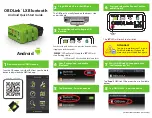
Teledyne API Model 401 O
3
Photometric Calibrator Instruction Manual, 01124, Rev. J1
The "X" indicates the message type as shown above in Table 7-1 and "COMMAND" is the
command type, each of which is described individually below.
The "<CRLF>" is used to terminate the command. Typing "<CRLF>" a few times by itself is a
good way to clear the input buffer of any extraneous characters.
7.1 DAS Reporting
Every N minutes (N is software selectable) the data acquisition system issues a report to the RS-
232 interface. This report shows the average O
3
reading during the last N minutes, the range, and
the number of 1-minute samples taken during that interval. The message format is:
"
R DDD:HH:MM IIII RANGE=xxxx O3=xxxx PPB SAMPLES=xx<CRLF>"
Whenever the Model 401 is in calibration or diagnostics mode, no O
3
readings are included in
the average. Thus, it is possible for an average to contain 0 samples. If the number of samples in
an average is 0, then "XXXX" is shown as the O
3
readings.
The host computer can request the DAS reports stored in the battery-backed RAM by means of
the command:
"
R NNN<CRLF>
"
where "NNN" is the number of reports requested (starting from the most recent one). The CPU
will output NNN reports to the RS-232 interface, each report having the following format:
"
R DDD:HH:MM IIII O3 PPB SAMPLES=xx<CRLF>
"
where the fields have the same meaning as described above. For example, if the last DAS report
was at 10:00 a.m. and the report frequency is 60 minutes and the host computer requests the most
recent 3 reports by issuing the command:
"
R 3<CRLF>
"
and the CPU will respond by outputting something like the following:
"
R 91:08:00 0000 O3= 0 PPB SAMPLES=60<CRLF>
"
"
R 91:09:00 0000 O3= 2 PPB SAMPLES=60<CRLF>
"
"
R 91:10:00 0000 O3= 0 PPB SAMPLES=60<CRLF>
"
7-2
















































